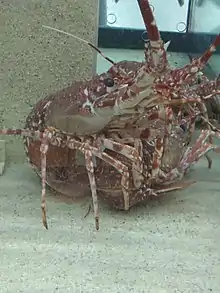| Palinurus mauritanicus | |
|---|---|
 | |
| Scientific classification | |
| Domain: | Eukaryota |
| Kingdom: | Animalia |
| Phylum: | Arthropoda |
| Class: | Malacostraca |
| Order: | Decapoda |
| Suborder: | Pleocyemata |
| Family: | Palinuridae |
| Genus: | Palinurus |
| Species: | P. mauritanicus |
| Binomial name | |
| Palinurus mauritanicus Gruvel, 1911 | |
| Synonyms[2] | |
| |
Palinurus mauritanicus (common name: pink spiny lobster) is a species of spiny lobster. It is found in deep waters in the eastern Atlantic Ocean and the western Mediterranean Sea.
Description
The pink spiny lobster differs from Palinurus elephas, by its first pair of pereiopods (walking legs) that are as slender as its other pereiopods. The carapace shows two conspicuous, longitudinal rows of forward-directed spines. The peduncle, the base segment of the antenna, is particularly stout.
The pink spiny lobster may attain an age of at least 21 years.[3]
Distribution and habitat
It is distributed from south-western Ireland southwards throughout the western Mediterranean Sea (as far east as to Sicily, but not in the Adriatic Sea) and along the West African coast to Senegal. Palinurus mauritanicus and Palinurus elephas, are the only species of the family Palinuridae that occur both in the northeastern Atlantic Ocean and the Mediterranean Sea.
It is found on muddy or rocky bottoms at the edge of the continental shelf, but, off Europe in waters deeper than 200 m. Its greatest numbers occur at depths of between 200 and 400 metres (660 and 1,310 ft).[4] The males seem more abundant at depths above 250 m while females and juveniles are found at greater depths.
Diet
Palinurus mauritanicus lives as a scavenger from dead fish, but also hunts live molluscs, other crustaceans, polychaetes and echinoderms.[3]
Reproduction
The breeding season is between late summer and autumn, shortly after moulting. Females may carry up to 60,000 eggs. The study of larval ecology is scant. The hatching of the larvae happens after about three months as planktonic larvae (phyllosoma larvae).[3] These larvae can be distinguished from other palinurid larvae by their pereiopods 4 and 5 being already present as small buds and by the long, non-setose exopod on pereiopod 3.[5]
Uses
Palinurus mauritanicus has been less the preferred target of lobster fisheries because of its relative scarcity, due to its deeper distribution. Its main fishing range is in the eastern central Atlantic off Mauritania. Its high unit value has led to depletion in the eastern central Atlantic.
References
- ↑ Cockcroft, A.; Butler, M.; MacDiarmid, A. (2011). "Palinurus mauritanicus". IUCN Red List of Threatened Species. 2011: e.T170035A6715683. doi:10.2305/IUCN.UK.2011-1.RLTS.T170035A6715683.en. Retrieved 19 November 2021.
- ↑ Lipke B. Holthuis (1991). "Palinuus mauritanicus". FAO Species Catalogue, Volume 13. Marine Lobsters of the World. FAO Fisheries Synopsis No. 125. Food and Agriculture Organization. pp. 121–122. ISBN 92-5-103027-8. Archived from the original on 2011-06-07. Retrieved 2010-06-18.
- 1 2 3 Maigret, J. (1978). Contribution à l'étude des langoustes de la côte occidentale de l'Afrique (in French). Aix-Marseille University. pp. 264 pp.
- ↑ Postel, E. (1966). "Langoustes de la zone intertropical africaine". Mémoires de l'Institut Fondamental de l'Afrique Noire (in French). 77: 397–474.
- ↑ Palero, Ferran; Abelló, Pere (2007). "The first phyllosoma stage of Palinurus mauritanicus (Crustacea: Decapoda: Palinuridae)". Zootaxa. 1508: 49–59. doi:10.11646/zootaxa.1508.1.2.
External links
- Raquel Goni & Daniel Latrouite (2005). "Review of the biology, ecology and fisheries of Palinurus spp. species of European waters : Palinurus elephas and Palinurus mauritanicus" (PDF). Cahiers de Biologie Marine. 46: 127–142.
